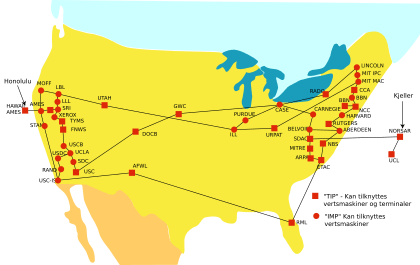ARPANET facts for kids
The Advanced Research Projects Agency Network (ARPANET) was the world's first packet switching network. It was created by the Advanced Research Projects Agency (ARPA) of the United States Department of Defense. ARPANET was a very important early computer network. It helped lay the groundwork for what we now know as the global Internet.
Contents
What Was ARPANET?
ARPANET was a groundbreaking computer network. It allowed different computers to talk to each other, even if they were far apart. Imagine being able to share information and use powerful computers from anywhere! This was a big deal in the 1960s.
Why Was ARPANET Created?
The main goal of ARPANET was to help scientists and researchers share information and computer resources. The United States Department of Defense wanted a way for researchers at different universities and labs to connect. This would help them work together on important projects.
Sharing Computer Power
In the early days, computers were very expensive and large. Not every university or research center had access to the most powerful ones. ARPANET allowed researchers to share these valuable computer resources. For example, someone at one university could use a supercomputer located at another university.
Reliable Communication
Another reason for ARPANET was to create a communication network that could keep working even if parts of it were damaged. This was important during the Cold War. The idea was that if one path for data was blocked, the information could find another way to its destination.
How ARPANET Worked
ARPANET used a new technology called packet switching. This was a revolutionary idea for sending data.
Understanding Packet Switching
Before packet switching, most communication networks used a method called "circuit switching." Think of it like a phone call: once you dial, you have a dedicated line to the other person. This line stays open for the whole call.
Packet switching is different. When you send information (like a message or a file) over ARPANET, it gets broken down into small pieces called packets. Each packet has the address of where it needs to go. These packets then travel independently through the network. They might even take different paths to reach the same destination! Once all the packets arrive, they are put back together in the correct order.
Benefits of Packet Switching
- Efficiency: Many different messages can share the same network lines at the same time. This is like many cars sharing a highway instead of each car having its own private road.
- Reliability: If one path in the network is busy or breaks down, packets can simply find another way. This makes the network very robust and less likely to fail completely.
- Flexibility: It allowed different types of computers to connect and communicate, even if they were made by different companies.
Key Moments in ARPANET's History
ARPANET's journey began in the late 1960s and continued for over two decades.
The First Connection
The very first message sent over ARPANET happened on October 29, 1969. It was sent from a computer at the University of California, Los Angeles (UCLA) to a computer at the Stanford Research Institute (SRI). The message was supposed to be "LOGIN," but only the letters "L" and "O" were sent before the system crashed! They quickly fixed it, and the full message was sent shortly after.
Growing the Network
After the first connection, ARPANET quickly grew.
- By the end of 1969, there were four main computers connected.
- In 1971, the first email program was developed for ARPANET. This was a huge step for communication!
- By 1973, ARPANET had connections across the United States and even to some international locations.
The Birth of the Internet
As ARPANET grew, other networks started to appear. Scientists realized they needed a way for all these different networks to talk to each other. This led to the development of new communication rules, called protocols, like TCP/IP.
These protocols allowed different networks to connect and form a "network of networks." This "internetwork" eventually became what we call the Internet. ARPANET was a core part of this early Internet.
ARPANET's Legacy
ARPANET officially stopped operating in 1990. By then, the Internet had grown much larger and was ready to take over. ARPANET's ideas and technologies, especially packet switching and the early protocols, were essential building blocks for the modern Internet we use every day. It showed that a large, distributed network could work and be incredibly useful.
Images for kids
See also
 In Spanish: ARPANET para niños
In Spanish: ARPANET para niños



